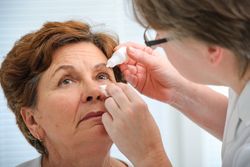
Eyes always need to be moisturized, as the lack of lubrication can cause pain and additional problems. That’s why you should contact an optometrist if you feel any cause for concern. They can determine whether you have dry eye, which means tears don’t provide enough lubrication for the ocular structure. To expand your knowledge of why the condition develops and how it can be treated, find answers to frequently asked questions about dry eye here.
4 Questions About Dry Eye Answered
What causes the condition?
There are numerous reasons why an eye can’t create enough tears. This could be the case when tear ducts aren’t working due to damage. Certain diseases, such as diabetes and lupus, or medications can also impair tear production.
If tear production is normal, the quality of the lubrication can also cause dry eye. Tears are a mixture of oil, water, and mucus. The correct balance of all three substances is needed to prevent the condition. It’s also possible for the lubrication to evaporate too quickly due to exposure to wind or dry air. Infrequent blinking will also dry out eyes.
What are the common symptoms?
People who have the condition might feel a burning or itching sensation in one or both eyes. It might also feel like an eyelash or tiny particle is caught in the eye. Eyes might appear red from the irritation and begin watering for relief. The condition can also make it difficult to see objects clearly.
How is dry eye diagnosed?
 To test for dry eye, an optometrist might use blotting paper to measure tear volume. They might also administer eye drops that dye the ocular structure so they can take a look at the quality of the tears and how they coat the surface.
To test for dry eye, an optometrist might use blotting paper to measure tear volume. They might also administer eye drops that dye the ocular structure so they can take a look at the quality of the tears and how they coat the surface.
During the eye exam, the optometrist will also use various instruments to view the entire ocular structure. This investigation could unearth duct damage and other underlying abnormalities causing dry eye. They will also review a patient’s medical history for contributing factors.
What are my treatment options?
The severity of the condition determines how it should be treated. If there is minimal discomfort, artificial tears can supplement for the body’s lack of production. An eye doctor might also prescribe medication to stimulate natural tear production or treat the underlying conditions causing dry eye.
To restore your vision, comfort, and quality of life, contact Eric G. Stocker, OD. The Amherst, OH-based optometrist tests Lorain County residents for dry eye as well as glaucoma, cataracts, and other conditions impacting ocular health. To schedule an exam and discuss treatment options, call (440) 988-4419. Find out what to expect during the appointment online.
About the Business
Have a question? Ask the experts!
Send your question

